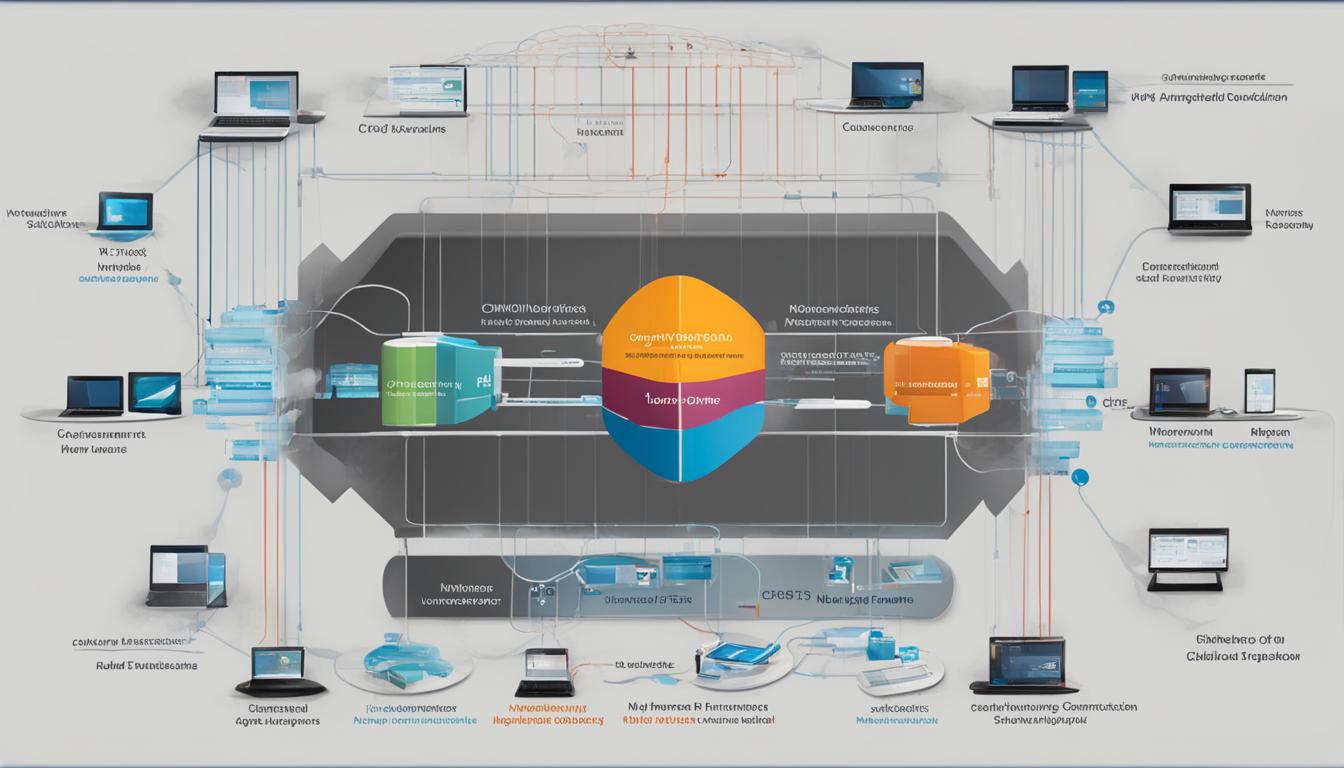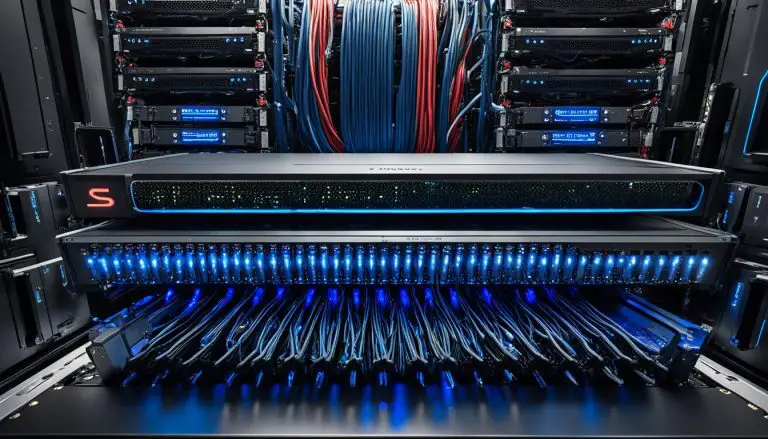Understanding Networking: What is the OSI Model?
The OSI (Open Systems Interconnect) model is a conceptual framework that describes networking or telecommunications systems as seven layers. Each layer has a specific function and helps network professionals visualize and troubleshoot issues within their networks. The layers of the OSI model are: Layer 1—Physical, Layer 2—Data Link, Layer 3—Network, Layer 4—Transport, Layer 5—Session, Layer 6—Presentation, and Layer 7—Application. The model was created in the 1970s and has remained relevant in networking technology today. Understanding the OSI model can help with protocol compatibility, device interoperability, and network troubleshooting.
Key Takeaways:
- The OSI model is a conceptual framework that describes networking systems with seven layers.
- Each layer of the OSI model has a specific function and helps troubleshoot network issues.
- The layers of the OSI model include Physical, Data Link, Network, Transport, Session, Presentation, and Application.
- The OSI model is relevant for protocol compatibility, device interoperability, and network troubleshooting.
- Understanding the OSI model aids in navigating the complexities of networking.
The Application Layer (Layer 7) of the OSI Model
The OSI model consists of seven layers, each serving a distinct purpose in the communication process. At the top of the model is the Application Layer or Layer 7. This layer is responsible for interacting with the end-user, making it one of the most critical layers in the OSI model. Its main role is to receive information directly from users and display incoming data.
The Application Layer enables communication through lower layers, establishing connections with applications at the other end. It plays a significant role in network protocols such as web browsing, TelNet, and FTP. These applications rely on Layer 7 to ensure seamless communication between the user and the network.
Understanding the Application Layer is crucial for network professionals as it provides insights into how applications interact with the underlying layers. By grasping its functionalities and protocols, network troubleshooting becomes more efficient, and compatibility between applications can be achieved.
The Application Layer (Layer 7) of the OSI Model
“The Application Layer is the gateway for users to access and interact with network services. It enables the seamless flow of data and communication, making it a vital layer in the OSI model.” – Network Professional
Table: Comparison of OSI Model Layers
| Layer | Function | Example Protocols |
|---|---|---|
| Application | Interacts with end-users and displays incoming data | HTTP, FTP, TelNet |
| Presentation | Data formatting and translation | TLS, SSL |
| Session | Establishes, manages, and terminates conversations | NetBIOS |
| Transport | Coordination of data transfer between systems | TCP, UDP |
| Network | Packet forwarding and routing | IP, ICMP |
| Data Link | Node-to-node data transfer and error correction | Ethernet, ATM |
| Physical | Physical representation of the network | Copper cables, fiber optics |
The Presentation Layer (Layer 6) of the OSI Model
The Presentation Layer, also known as Layer 6, plays a crucial role in the OSI model. This layer is responsible for data formatting and translation at the application layer, ensuring that data can be efficiently transmitted between different systems. It acts as a bridge between the application layer and the lower layers, transforming data from the application format to the network format, or vice versa.
One of the key functions of the Presentation Layer is encryption and decryption of data for secure transmission. This layer ensures that sensitive information is protected during communication. By encrypting data at the sender’s end and decrypting it at the receiver’s end, the Presentation Layer helps maintain the confidentiality and integrity of the transmitted data.
The Presentation Layer also handles tasks such as data compression and decompression, ensuring efficient data transfer over the network. By compressing data before transmission, it reduces the bandwidth required, leading to faster transmission speeds and improved network performance.
Examples of the Presentation Layer in Action
Let’s take a look at some real-world examples of how the Presentation Layer functions. When you browse the internet using a web browser, the Presentation Layer is responsible for rendering web pages and displaying the content in a user-friendly format. It takes the data received from the network and converts it into a visual representation that you can easily understand and interact with.
Another example is when you send an email with an attachment. The Presentation Layer takes the file you attach and converts it into a format that can be transmitted over the network. The receiver’s Presentation Layer then converts the data back into the original file format, allowing them to access and view the attached file.
In summary, the Presentation Layer of the OSI model plays a vital role by handling data formatting, encryption, compression, and decompression tasks. It ensures that data is transformed into the appropriate format for transmission and helps maintain the security and efficiency of network communication.
| Layer | Responsibilities |
|---|---|
| Layer 6: Presentation |
|
The Session Layer (Layer 5) of the OSI Model
The Session Layer, also known as Layer 5 of the OSI model, plays a crucial role in establishing, managing, and terminating conversations between applications. This layer acts as a mediator between the application layer and the transport layer, ensuring seamless communication between them. One of the primary functions of the Session Layer is to handle the setup, coordination, and termination of sessions between applications at each end.
Authentication is another key function of the Session Layer. It verifies the identities of communicating entities, ensuring secure and authorized access to the network. This layer also supports features like reconnection and timeout settings, which help in maintaining the integrity and continuity of sessions.
Session Layer Key Functions:
- Establishing, managing, and terminating conversations between applications
- Authentication and authorization of communicating entities
- Supporting reconnection and timeout settings for session continuity
By providing these essential functions, the Session Layer enables reliable and secure communication between applications. It ensures that data is transferred accurately and efficiently, maintaining the overall integrity of the network.
“The Session Layer acts as a bridge between the application layer and the transport layer, providing a seamless connection for data exchange.” – Network Specialist
| OSI Model Layer | Layer Name | Primary Functions |
|---|---|---|
| Layer 7 | Application Layer | Interacts with the end-user and displays incoming data |
| Layer 6 | Presentation Layer | Formats and translates data between application and network formats |
| Layer 5 | Session Layer | Establishes, manages, and terminates conversations between applications |
| Layer 4 | Transport Layer | Coordinates data transfer between end systems and hosts |
| Layer 3 | Network Layer | Handles packet forwarding and routing between networks |
| Layer 2 | Data Link Layer | Provides node-to-node data transfer and error correction |
| Layer 1 | Physical Layer | Represents the electrical and physical aspects of the network |
The Transport Layer (Layer 4) of the OSI Model
The Transport Layer, also known as Layer 4 of the OSI model, plays a crucial role in the coordination of data transfer between end systems and hosts. It ensures that data is delivered reliably and efficiently across the network. One of the most well-known examples of the Transport Layer is the Transmission Control Protocol (TCP), which is responsible for establishing connections, breaking data into packets, and reassembling them at the destination.
The Transport Layer determines how much data to send, at what rate, and where it needs to go. It adds a layer of reliability by providing mechanisms for error detection, acknowledgment of received data, and retransmission in case of packet loss. This layer is essential for applications that require a guaranteed delivery of data, such as file transfer or real-time streaming.
To illustrate the importance of the Transport Layer, consider a scenario where you are downloading a large file from a remote server. The Transport Layer ensures that the file is divided into smaller packets and reassembled correctly at your end, even if some packets get lost or arrive out of order during transmission. Without the Transport Layer, data transfer would be unreliable, and you would not be able to download files or stream videos seamlessly.
Table: Comparison of Transport Layer Protocols
| Protocol | Description | Key Features |
|---|---|---|
| TCP | Transmission Control Protocol | Reliable delivery, flow control, congestion control |
| UDP | User Datagram Protocol | Connectionless, unreliable delivery, low overhead |
The Transport Layer is a vital component of the OSI model, responsible for ensuring reliable data transfer between end systems. It provides mechanisms for error detection, packet retransmission, and congestion control. Protocols like TCP and UDP operate at this layer, each offering unique characteristics to suit different network requirements.
In summary, the Transport Layer of the OSI model enables the efficient and dependable transfer of data across networks. It ensures that data is delivered intact and in the correct order, providing a reliable foundation for applications to communicate effectively. By understanding the Transport Layer and its functions, network professionals can optimize their networks for secure and efficient data transmission.
The Network Layer (Layer 3) of the OSI Model
The Network Layer, also known as Layer 3 of the OSI model, plays a critical role in ensuring efficient data transfer between different networks. It is primarily responsible for packet forwarding and routing through various routers, enabling data to reach its destination. By determining the best path for data transmission, the Network Layer helps optimize network performance and minimize latency.
The Network Layer operates at a higher level than the Data Link Layer (Layer 2) and the Physical Layer (Layer 1), allowing it to interact with different networks and handle address resolution. Routers are key devices that operate at Layer 3, using IP addresses to direct packets towards their intended destinations. They analyze routing tables and make decisions based on network conditions to ensure reliable and timely delivery of data.
Benefits of the Network Layer:
- Efficient packet forwarding and routing between networks
- Optimization of network performance by choosing the best path for data transmission
- Address resolution and management through the use of IP addresses
- Improved scalability and flexibility in network design
- Enhanced network security by implementing measures such as firewalls and access control
“The Network Layer, as part of the OSI model, plays a crucial role in ensuring the smooth flow of data between different networks. It provides the necessary routing and addressing capabilities to achieve efficient and reliable communication.”
By understanding the intricacies of the Network Layer, network professionals can design robust and scalable networks, troubleshoot connectivity issues, and implement effective security measures. The Network Layer’s importance in the OSI model cannot be overstated, as it serves as the backbone for reliable and seamless communication.
| Layer | Function |
|---|---|
| Layer 1 | Physical: Represents the electrical and physical representation of the network. |
| Layer 2 | Data Link: Provides node-to-node data transfer and handles error correction from the Physical Layer. |
| Layer 3 | Network: Responsible for packet forwarding and routing through different routers. |
| Layer 4 | Transport: Coordinates data transfer between end systems and hosts. |
| Layer 5 | Session: Establishes, manages, and terminates conversations between applications. |
| Layer 6 | Presentation: Handles data formatting and translation at the application layer. |
| Layer 7 | Application: Interacts with the end-user and displays incoming data. |
The Data Link Layer (Layer 2) of the OSI Model
The Data Link Layer is a crucial component of the OSI model, residing just above the Physical Layer. This layer provides node-to-node data transfer and handles error correction from the Physical Layer. The Data Link Layer consists of two sublayers: the Media Access Control (MAC) layer and the Logical Link Control (LLC) layer.
The MAC layer is responsible for controlling access to the network media and ensuring that multiple devices can share the communication channel without collisions. It assigns unique physical addresses, known as MAC addresses, to every network interface card (NIC) in a local area network (LAN). The MAC addresses are used to identify devices within the same LAN segment.
The LLC layer, on the other hand, handles the flow of data between devices on the same network segment. It manages the logical connection between the sending and receiving devices, allowing for error detection and recovery. The LLC layer also ensures that data is delivered in the correct order and provides mechanisms for flow control.
| Data Link Layer (Layer 2) | Function |
|---|---|
| Media Access Control (MAC) Layer | Controls access to the network media and assigns unique MAC addresses |
| Logical Link Control (LLC) Layer | Handles flow control, error detection and recovery, and data sequencing |
The Data Link Layer is where switches operate, functioning as intelligent devices that facilitate data transfer between directly connected nodes. Switches use MAC addresses to determine the destination of incoming data and forward it only to the appropriate device. This layer also performs error checking to ensure reliable data transmission.
The Physical Layer (Layer 1) of the OSI Model
The Physical Layer is the first layer of the OSI model and plays a vital role in network communication. It focuses on the electrical and physical aspects of transmitting data, ensuring that information is transmitted accurately and reliably across the network. The Physical Layer defines the physical medium used for communication, such as cables, connectors, and wireless signals. It also determines the encoding and modulation techniques used to transmit data over these mediums.
At the Physical Layer, data is represented in binary form, consisting of bits that are transmitted as electrical signals or light pulses. This layer is responsible for converting these signals into a format suitable for transmission and reception by network devices. It handles tasks such as signal generation, data encoding, and physical transmission, ensuring that the data is sent from one network device to another.
Some of the key functions of the Physical Layer include establishing and terminating connections, detecting errors in transmission, and managing the physical characteristics of the network. It ensures that the network interface cards (NICs) of devices can send and receive data correctly, sets the voltage levels for signaling, and determines the physical topology of the network. Troubleshooting at this layer involves checking cable connections, verifying signal strength, and confirming that the physical components of the network are functioning properly.
Physical Layer Key Points:
- The Physical Layer is responsible for the electrical and physical aspects of network communication.
- It defines the physical medium used for transmission, such as cables and wireless signals.
- Data is represented in binary form at the Physical Layer and transmitted as electrical signals or light pulses.
- Key functions of the Physical Layer include establishing connections, detecting errors, and managing network physical characteristics.
- Troubleshooting at this layer involves checking cable connections and verifying signal strength.
The Physical Layer is the foundation of the OSI model, ensuring that data is transmitted reliably and accurately across the network. By understanding the intricacies of this layer, network professionals can diagnose and resolve physical connectivity issues, ensuring optimal performance and efficiency within the network infrastructure.
| OSI Model Layer | Layer Name | Function |
|---|---|---|
| Layer 7 | Application Layer | Interacts with the end-user and facilitates communication with applications |
| Layer 6 | Presentation Layer | Handles data formatting and translation at the application layer |
| Layer 5 | Session Layer | Establishes, manages, and terminates conversations between applications |
| Layer 4 | Transport Layer | Coordinates data transfer between end systems and hosts |
| Layer 3 | Network Layer | Handles packet forwarding and routing through different routers |
| Layer 2 | Data Link Layer | Provides node-to-node data transfer and error correction |
| Layer 1 | Physical Layer | Represents the electrical and physical representation of the network |
The Relevance and Benefits of the OSI Model in Networking
The OSI model, or Open Systems Interconnect model, continues to hold significant relevance in the networking industry today. Serving as a standardized framework, it provides a comprehensive understanding of network communication and enables interoperability between different technologies. The OSI model is widely used in network certification exams, aiding professionals in comparing and contrasting various protocols and technologies.
One of the key advantages of the OSI model is its application in network security. By outlining the different layers of communication, it helps identify potential vulnerabilities and design robust security measures. Additionally, the OSI model assists in infrastructure planning, as it provides a structured approach to network design, implementation, and troubleshooting.
Benefits of the OSI Model
The OSI model offers several benefits for networking professionals:
- Standardized Communication Protocols: The OSI model establishes a common language for network protocols, ensuring efficient and seamless communication between different devices and systems.
- Flexibility in Adapting to Various Technologies: As technology evolves, the OSI model remains adaptable, accommodating new networking technologies and protocols.
- Improved Network Security: By understanding the different layers of communication, network administrators can implement robust security measures and protect against potential threats.
- Categorization and Organization of Data Transmissions: The OSI model aids in the efficient categorization and organization of data transmissions, making network management and troubleshooting more streamlined.
- Enhanced Network Visibility: With the OSI model, networking professionals can gain a deeper understanding of network traffic, allowing for better analysis and optimization.
- Universal Vocabulary: The OSI model provides a universal vocabulary for networking professionals, ensuring clear and concise communication across the industry.
The OSI model remains an essential tool for network professionals, offering a structured framework for understanding network communication and facilitating efficient and secure data transfer. By incorporating the OSI model into their practice, networking professionals can enhance network performance, troubleshoot issues effectively, and ensure the overall reliability of their networks.
| OSI Model Relevance and Benefits |
|---|
| Standardized Communication Protocols |
| Flexibility in Adapting to Various Technologies |
| Improved Network Security |
| Categorization and Organization of Data Transmissions |
| Enhanced Network Visibility |
| Universal Vocabulary |
Benefits of the OSI Model
The OSI model offers numerous advantages that make it a valuable framework for understanding network communication. These benefits contribute to its continued relevance in the networking industry:
- Standardized Communication Protocols: The OSI model provides a standardized approach to network communication, ensuring compatibility between different systems and technologies. This standardization enables seamless data transfer across diverse networks and facilitates interoperability.
- Flexibility to Adapt: The OSI model’s layered structure allows for flexibility in adapting to various technologies and protocols. Each layer performs a specific function, making it easier to incorporate new technologies or modify existing ones without disrupting the entire network architecture.
- Improved Network Security: By dividing network communication into distinct layers, the OSI model enhances network security. Each layer can implement security measures specific to its function, such as encryption and authentication, to protect data and prevent unauthorized access.
In addition to these key benefits, the OSI model also aids in categorizing and organizing data transmissions, enhancing network visibility, and providing a universal vocabulary for networking professionals. Its comprehensive nature and continued relevance in the industry make it an essential concept for anyone working with computer networks.
Table: OSI Model Advantages
| Advantage | Description |
|---|---|
| Standardized Communication Protocols | The OSI model provides a standardized approach to network communication, ensuring compatibility between different systems and technologies. |
| Flexibility to Adapt | The layered structure of the OSI model allows for easy adaptation to various technologies and protocols without disrupting the entire network architecture. |
| Improved Network Security | The division of network communication into distinct layers enables the implementation of specific security measures at each layer, enhancing overall network security. |
| Categorization and Organization of Data Transmissions | The OSI model helps in categorizing and organizing data transmissions, making it easier to manage and troubleshoot network issues. |
| Enhanced Network Visibility | By providing a clear structure and delineation of functions, the OSI model enhances network visibility, making it easier to identify and address network-related problems and inefficiencies. |
| Universal Vocabulary for Networking Professionals | The OSI model provides a universal vocabulary for networking professionals, enabling effective communication and collaboration across different organizations and industries. |
OSI Model vs. TCP/IP Model
When it comes to networking, two prominent models have shaped the way we understand and implement network protocols: the OSI (Open Systems Interconnect) model and the TCP/IP model. While both models serve as frameworks for communication, they differ in terms of their structure and layer organization.
The OSI model consists of seven layers, each with a specific function and responsibility. These layers include the Physical, Data Link, Network, Transport, Session, Presentation, and Application layers. The TCP/IP model, on the other hand, is composed of four layers: the Network Interface, Internet, Transport, and Application layers.
One of the key differences between the two models lies in their adoption and implementation. The OSI model, despite providing a comprehensive framework, is less widely implemented in practice. In contrast, the TCP/IP model is the most commonly used protocol suite in networking, driving the functionality of the internet.
While the OSI model offers a more detailed and comprehensive view of network communication, the TCP/IP model simplifies the process by consolidating certain layers. This consolidation allows for a more streamlined approach, making it easier to understand and implement network protocols.
Overall, both the OSI model and TCP/IP model have their own strengths and applications. The OSI model provides a deeper understanding of networking concepts and troubleshooting techniques, while the TCP/IP model offers practicality and ease of implementation. Ultimately, the choice between the two models depends on the specific needs and requirements of the networking environment.
Conclusion
After exploring the OSI model and its various layers, it is clear that this conceptual framework plays a vital role in the world of networking. By understanding the OSI model, network professionals gain valuable insights into the functioning and troubleshooting of their networks.
The OSI model’s seven layers provide a structured approach to network communication, ensuring protocol compatibility and device interoperability. It offers a standardized model that helps in comparing various technologies and protocols, making it an essential tool for network certification exams.
Moreover, the OSI model’s relevance extends beyond certification exams. It aids in network security, infrastructure planning, and provides a universal vocabulary for networking professionals. By embracing the OSI model, network professionals can enhance network visibility, categorize data transmissions, and adapt to the ever-changing landscape of networking technologies.
In conclusion, the OSI model remains an indispensable concept in the networking industry. Its benefits, including standardized communication protocols, flexibility, and improved network security, make it an invaluable resource for any network professional. By delving into the layers of the OSI model, professionals can navigate the complexities of networking with confidence.
FAQ
What is the OSI model?
The OSI (Open Systems Interconnect) model is a conceptual framework that describes networking or telecommunications systems as seven layers.
How many layers are there in the OSI model?
The OSI model consists of seven layers: Physical, Data Link, Network, Transport, Session, Presentation, and Application.
What is the Application Layer (Layer 7) responsible for?
The Application Layer interacts with the end-user, receives information directly from users, and displays incoming data. It facilitates communication through lower layers to establish connections with applications at the other end.
What is the Presentation Layer (Layer 6) responsible for?
The Presentation Layer is responsible for data formatting and translation at the application layer. It prepares or translates data from the application format to the network format, or vice versa. Encryption and decryption of data for secure transmission occur at Layer 6.
What is the Session Layer (Layer 5) responsible for?
The Session Layer establishes, manages, and terminates conversations between applications. It handles setup, coordination, and termination between the applications at each end of the session. Functions at this layer include authentication, reconnection, and timeout settings.
What is the Transport Layer (Layer 4) responsible for?
The Transport Layer is responsible for the coordination of data transfer between end systems and hosts. It determines how much data to send, at what rate, and where it goes. The best-known example of the Transport Layer is the Transmission Control Protocol (TCP), which ensures reliable data delivery.
What is the Network Layer (Layer 3) responsible for?
The Network Layer is where most router functionality resides. It is responsible for packet forwarding and routing through different routers. This layer ensures efficient data transfer between different networks and helps in determining the best path for data transmission.
What is the Data Link Layer (Layer 2) responsible for?
The Data Link Layer provides node-to-node data transfer and handles error correction from the physical layer. It consists of two sublayers: the Media Access Control (MAC) layer and the Logical Link Control (LLC) layer. Switches operate at Layer 2 and handle data transfer between directly connected nodes.
What is the Physical Layer (Layer 1) responsible for?
The Physical Layer represents the electrical and physical representation of the network. It includes aspects such as cable types, radio frequency links, and physical requirements. Troubleshooting at this layer involves checking cable connections and power supply.
Why is the OSI model relevant in networking?
The OSI model provides a standard model for understanding network communication and enables interoperability between different technologies. It is used for network certification exams, helps in comparing and contrasting different protocols and technologies, and aids in network security and infrastructure planning.
What are the benefits of the OSI model?
The benefits of the OSI model include standardized communication protocols, flexibility to adapt to various technologies, improved network security, categorizing and organizing data transmissions, enhanced network visibility, and providing a universal vocabulary for networking professionals.
What are the differences between the OSI model and the TCP/IP model?
The OSI model consists of seven layers, while the TCP/IP model has four layers. The OSI model is more comprehensive but less implemented in practice, while TCP/IP is the most commonly used network protocol suite.
What is the importance of understanding the OSI model in networking?
Understanding the OSI model helps network professionals with protocol compatibility, device interoperability, and network troubleshooting. It allows for a better understanding of network communication and aids in navigating the complex world of networking.
- About the Author
- Latest Posts
Mark is a senior content editor at Text-Center.com and has more than 20 years of experience with linux and windows operating systems. He also writes for Biteno.com






